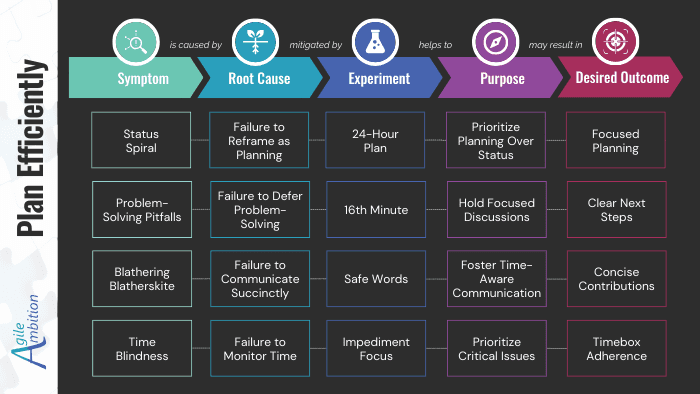Racing the Clock: Plan Efficiently

A navigation check isn’t about repairing the ship; it’s about recalibrating the course. Are you using your Daily Scrum to align or to problem-solve?

Have you been in Daily Scrums that feel more like performance reviews than planning sessions—with team members justifying their paychecks instead of aligning on the work ahead? There’s always that one person who dives into irrelevant details, derailing the conversation. Then, someone raises a problem, and half the team gets pulled into a discussion that only matters to two people. No one watches the clock; before you know it, the 15-minute timebox is long gone. What should be a quick, focused check-in devolves into yet another time-sucking meeting that leaves everyone frustrated and behind schedule.
In this issue, you’ll explore four experiments to help you reclaim your time.
From Status Spiral to Focused Planning

The biggest misconception about the Daily Scrum? It’s not a status meeting. It’s a navigational check. Are we on track for our goal? What did you learn yesterday that impacts today? What’s your next step? Need help? Have blockers? Great—say it quickly, and save problem-solving for later. The Scrum’s job isn’t to dive into every detail; it’s to plan the next 24 hours. When you skip the play-by-play of everything you’ve done and focus on aligning the team, the meeting becomes sharp, actionable, and—dare I say—efficient.
24 Hour Plan keeps your Scrum focused, actionable, and aligned.
🤔 What would happen if your team spent less time rehashing the past and more time planning the next 24 hours?
From Problem-Solving Pitfalls to Clear Next Steps

As a developer, you are a critical thinker and problem solver. When someone raises an impediment in the Daily Scrum, it’s natural to want to dive into solutioning. But doing so isn’t respectful to others in the meeting who either can’t contribute or aren’t impacted by the issue. Instead of turning the Scrum into a problem-solving session, frame impediments as opportunities for focused follow-ups. For example: “I need help resolving a time zone bug. Can three volunteers meet after Scrum for a quick problem-solving session?” This approach, often called the “16th minute,” keeps the Scrum efficient while allowing others to focus on their work.
16th Minute ensures focused problem-solving without derailing the Daily Scrum.
🤔 What would change if your team saved problem-solving for focused follow-ups?
From Blathering Blatherskite to Concise Contributions

Not everyone on your team may have mastered concise communication—but you can help them develop it. Without intervention, the most notorious blatherer will easily fill the entire 15-minute Scrum with just the first of their five updates. The first step is recognizing the problem. Scrum is a team sport—‘one for all and all for one’—so help your team improve. Use “safe words”—agreed-upon phrases that gently signal when someone’s rambling—to build awareness, prompt correction, and foster concise, meaningful contributions.
Safe Words promote awareness and encourage concise, focused team communication.
🤔 Are you creating a culture where team members feel comfortable redirecting discussions constructively?
From Time Blindness to Timebox Adherence

Does your company culture dictate meetings continue until the goal is achieved? This mindset often leads to overruns when facilitators misjudge the time required. To respect the timebox, you must combat time blindness. Time is money—assign someone to monitor the clock. As the timebox winds down, shift the focus to impediments, using the “16th minute” or focused discussions afterward to resolve them. Proper collaboration means this isn’t your only touchpoint, and tomorrow’s Scrum offers another chance to improve concise and timely communication. Ignoring the timebox removes motivation to improve while honoring it fosters discipline and efficiency.
Impediment Focus trims discussions, ensuring timebox adherence when time runs short.
🤔 What cultural shifts are needed to ensure timeboxing becomes a non-negotiable team norm?
TLDR;
Your Daily Scrum is a navigation check, not a repair shop. Stay on course, skip the detours, and save problem-solving for later.

Plot a new course—try one experiment this Sprint and see where it takes you.
Share
Table Of Contents
Fuel an Idea
Every week, I break down complex ideas, strip away the fluff, and give you experiments to turn knowledge into skills.
If that’s worth a coffee, consider fueling the next big insight.
No pressure. No guilt trips. Just impact.
Buy Me a CoffeeRelated Posts
Quick Links
Legal Stuff

